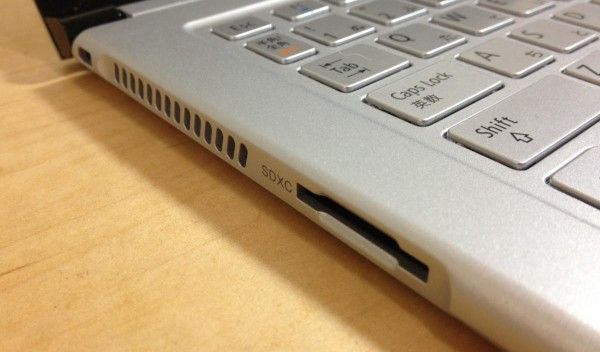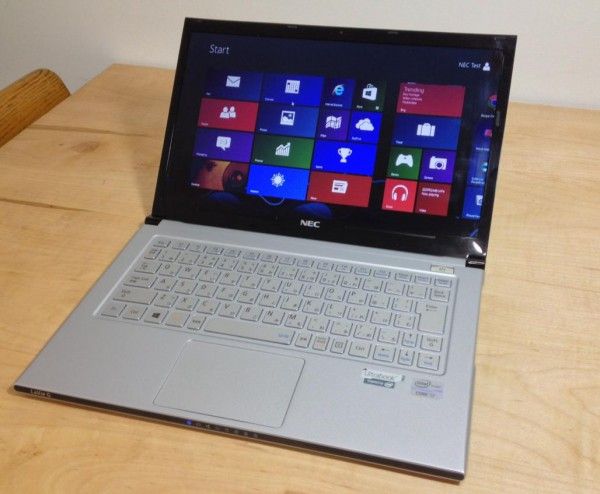Screen
The thin bezel around the 1600×900 display is great. The bezel is only 9mm (0.35 inches) on the sides and 15mm (0.59 inches) on the top. This isn’t much different than, say, the UX31E which is 16mm (0.62 inches) on the sides and 20mm (0.78 inches) on the top, but somehow it makes a more significant difference than I thought it would. Thanks to the thin bezel, the content of the screen seems more present. The lid itself is very thin too, slightly less than 5mm(0.19 inches). The thinness of the lid makes it feel a bit flimsy, though it was never an issue during use.
The 1600×900 resolution is ideal for a 13.3-inch display in my opinion. In Chippy’s time with the Dell XPS 12, which has a 1920×1080 12.5-inch display, he found that the text was just too small.
The LCD panel isn’t anything better than you’d expect from any other LCD — the contrast ratio isn’t very good compared to OLED displays and the horizontal viewing angles are reasonable. Beyond a certain angle you’ll see some colors get funky, but it’s not much of an issue in the horizontal plane. Unfortunately the vertical viewing angles leave a bit to be desired — you’ll lose some contrast if you aren’t in the display’s sweet-spot, so you’ll want to adjust the tilt of the display to make sure you’re looking at the right angle.
Otherwise, the screen is sharp and looks pretty good, especially with the bold colors and sharp lines of Windows 8.
Speakers and Fan Noise
The stereo speakers are located on the bottom of the Lavie Z. They are small but actually sound fairly clear. Unfortunately they are totally lacking in bass and won’t get very loud, but they are better than some other Ultrabooks I’ve tested. If they had a bit more power behind them they could actually be decent. They won’t cut it for any serious music listener, but they’ll get you by for YouTube videos.

The Lavie Z has a single fan with exhaust the comes out of the left side of the unit. The fan seems very silent. Even when running at full speed, the tiny speakers could even overpower it. I didn’t notice the fan running very often, but it’ll come on when you are doing graphically intensive tasks like gaming.
Software
The Lavie Z runs Windows 8. After using and hating Windows 8 for a few months I’ve got a bit of a bias toward it. Without a touchscreen, many of the changes in Windows 8 just feel like extra confusion. That’s not a knock against the Lavie Z though; every other new Ultrabook is shipping with Windows 8 as well. We’re not going to delve into the ins and outs of Windows 8 in this review, there’s plenty of commentary on that front already — take a query to your favorite search provider to find out more.
I hate to give you a boring software section, but the fact is: there was zero bloatware on the Lavie Z as far as we could tell, and that’s exactly the way we like it. A low number of processes reported by the task manager kept us confident as well. So… that’s that.












Great review Ben.
Zero bloatware is a true advantage and I think most Dynamism imports are built this way. Good job Dynamism.
Looking forward to batery life tests.
Chippy.
Cool stuff but will never every buy a ultrabook with 2 or less USB-ports again. Hope this trend doesnt stay, my freaking 500$ old 10inch notebook had freaking 3 usb-slots.
great device all ultrabooks should aspire to that weight sadly it is not readily available in europe it is something for the japanese market right?
In theory Lenovo has rights to rebrand and release it outside of Japan due to their deal with NEC.
Is the power plug compatible with the Thinkpad X1C adapter? It sure looks that way.
Hoping the battery life scores are decent. Probably still not enough for me, but maybe the Haswell version might be.
The HD 4000 is most probably underperforming other ultrabooks because the processor overperforms. CPU+GPU share overall TDP so more energy consuption by the CPU limits the energy available to the GPU, which is in effect throttled more aggressively.
Hence on Ultrabook with today’s generation of core it generally makes more sense not to have the fastest cpu, and even to have an i5 instead of an i7, even if it seems less sexy.
It could also be set to battery mode instead of performance mode. (in the GPU control panel)
I used our guide on maximizing Ultrabook perfromance (http://ultrabooknews.com/2012/07/12/how-to-optimize-your-ultrabook-for-maximum-gaming-performance/) before running the tests, so it should have been at top performance. I’m thinking that NEC turned down the graphics to help the battery life.
Did you get a chance to check CPU clockrate during tests. They may be using a tdp-down option which will limit CPU and affect the overall perf. The Samsung Series 5 for example, doesn’t have turbo enabled when on battery.
Strange indeed!
But one BIGGEST problem with them, – ONLY 4gb memory,that’s just a jole :(
I watched Intel’s Turbo Boost performance monitor during benchmarks and it seemed to be running at full power (but I think the graphics core might be separate).
Hi, could you elaborate a bit more on the vertical viewing angle? How much off center can you be before it starts to wash out? Also, how sturdy is the LCD hinge when the screen is open? Does it stay firmly in place or will it wiggle around? Lastly, any problems with the touchpad? I read some Japanese reviews and it seemed like people were complaining about it. Thanks.
Can you give review/test on color accuracy?
Thanks!